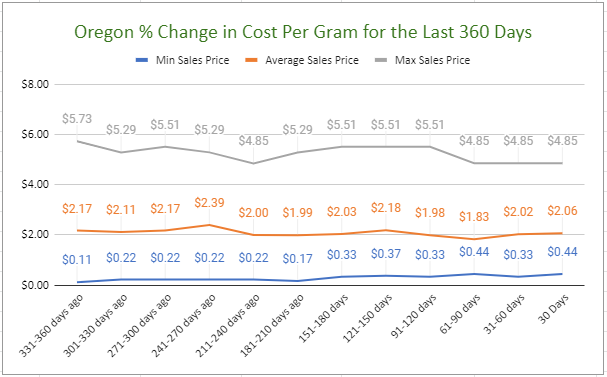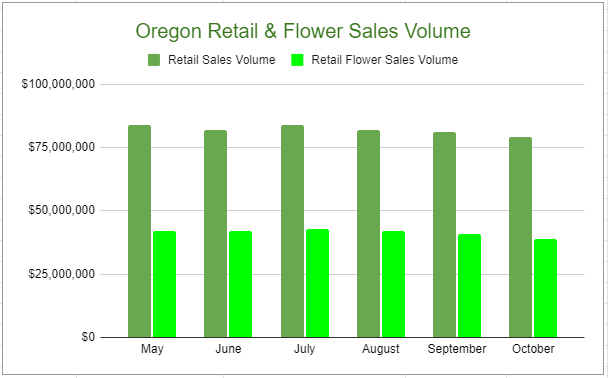
A Foretelling Glimpse Into Emerging and Mature Market Wholesale Cannabis Data
I and the leadership team at Apex Trading have been serving the cannabis industry ever since the first adult-use market came online in early 2014. Over the last 8 years we’ve seen new markets launch medical or adult-use programs and often the earliest of license holders benefit from strong market conditions with consumer demand outpacing production. Yet, these favorable conditions start to deteriorate within 2-3 years (sometimes faster) as more licenses are issued, new operations come online, and existing operations increase their production capacity. These factors, on top of the recent external economic and political forces, have resulted in most legacy markets experiencing a wholesale market crash where profit margins are so tight it forces operators out of the market or to take consolidation measures to remain in business.
You don’t need to be psychic to know that as most cannabis markets mature, wholesale prices drop due primarily to oversupply. However with a little look at the data and a bit of prognostication, the reasons become clearer.
What’s up with Oregon?
The Oregon wholesale flower market went through its first crash in 2018 and more recently has gone through another where it seems as though the market has now reached a point of saturation where production isn’t increasing and is instead decreasing as operators shut down or leave cannabis due to low to non-existent profit margins. That has resulted in prices being at an almost all-time low. Now that the floor has been reached (hopefully), very little continued price compression should occur unless greater external market forces come into play. As evidence of the market nearing the bottom, there were over 2 million fewer lbs. harvested in 2022 compared to 2021 according to the Portland Business Journal. However, retail sales have continued to fall month over month in OR, due to inflationary pressures, so while the bottom is close we might not be there yet.
However, while the average sales price has fallen there are still cultivators that have been able to hold to a higher price point compared to the market average. In the Oregon data set, you can see this in the maximum listing and sales prices. Why? These cultivators have established a strong brand with retailers and consumers alike, which is one of the key factors to being able to command a higher market price. Additionally, consistent high-quality harvests with attractive potency & terps solidify the brand value to the retailer and consumer.
Oregon Cannabis Market Details
Adult Use Since July 2016
Dispensaries – 822
Cultivators – 1,400
Residents – 4.2 Million
 Min Sales Price -31% Average Sales Price -5% Max Sales Price -15%
Min Sales Price -31% Average Sales Price -5% Max Sales Price -15%
 Reference – Oregon Liquor and Cannabis Commission
Reference – Oregon Liquor and Cannabis Commission
What about Massachusetts?
Massachusetts, on the other hand, has experienced a drastic 33% average sales price reduction over the last year. The even larger minimum sales price reduction of 56% could be an indicator that the bottom has yet to be reached and the market could very well start looking like Oregon in the near future as more cultivation and dispensaries enter the market.
There is one obvious factor that is contributing to the price drop in Massachusetts – more square feet of cultivation canopy continues to come online, increasing the amount of wholesale on the market. Simply looking at the Massachusetts open data, there were over 1 million or 75% more plants harvested on November 6th 2022 compared to the same date in 2021. As more and more facilities open the scales tip further in the oversupply direction driving prices down.
Massachusetts Cannabis Market Details
2018 Retail Sales Began
Dispensaries – 449
Cultivators – 347 (308 completed and approved, 115 final license, 193 provisional)
Residents – 7 Million

Min Sales Price -56% Average Sales Price -33% Max Sales Price -16%

Reference – Massachusetts Cannabis Control
Tax Revenue vs a Healthy Market
One might wonder why history continues to repeat itself? The wholesale market, specifically for flower, has crashed once or even multiple times in CO, WA, OR, CA and MI. Yet, all signs point to the Massachusetts market, as well as the majority of adult use states, to also follow this trend. There are a few reasons that are leading to this. First, the state governments have almost no incentive to limit the number of licensees because of the huge tax and licensing revenue opportunities as well as the desire to get rid of the illicit market. Second, unlike many agricultural industries, in cannabis the growers all operate independently without agreed-upon quality standards or production volumes to ensure a healthy market based on consumer demand. Additionally, without interstate commerce the regions where growing cannabis is most ideal are unable to reach the broader market. Maybe it’s time for the market stakeholders to band together and lobby, prior to the passing of adult use, that their politicians balance greed with creating a healthy market where operators can thrive while also continuing to push for interstate commerce.
What the future may hold / Importance of brand:
Cultivators are often the first and most severely impacted when it comes to oversupply and changing market conditions. Processors, on the other hand, benefit from the decrease in plant material costs resulting in higher profit margins but must remain aware of potential longer term per-unit price compression. This ultimately ties back to flower being closer to a commodity that is immediately impacted by the market supply vs demand dynamics as well as product characteristics such as potency.
Given this truth, it’s more important now than ever for cultivators / flower brands to focus on reducing cost of goods sales while establishing a strong brand presence and demand with retailers and consumers alike. Rather than rapidly scaling up to take advantage of short-term favorable market conditions, it may be better to stay small and ensure that every lb. grown has an established sales channel. Investments in cultivation automation & technology to reduce energy, water, and material costs is one step that can be taken, but often is capital intensive, which we all know that access to capital is a challenge many companies face. Additionally, these businesses could look to invest in an operations and sales management solution similar to what Apex Trading provides.
You don’t need a crystal ball to gain insights into the future of your cannabis market, just access to data and a smart team backing you up. This is just one aspect of how Apex Trading can help your company thrive. Our inventory, order and sales management tools are supporting hundreds of cannabis businesses across the US. If you’d like to learn more about Apex Trading, please schedule a call by clicking here or request a demo by clicking here.
